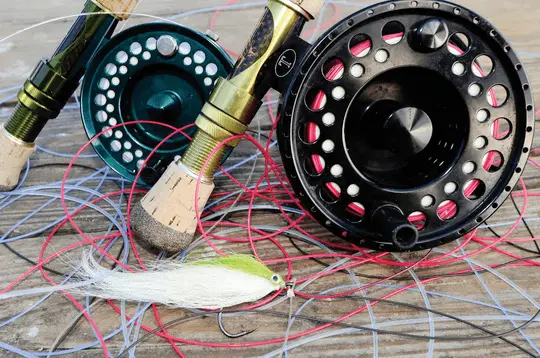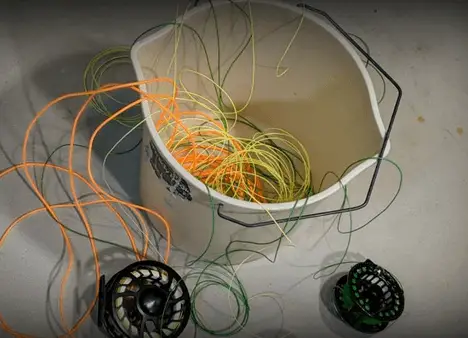Clean your fly line by first rinsing it in warm, soapy water then drying it thoroughly. Avoid using detergents that can damage the line’s coating.
Fly-fishing lovers understand the importance of maintaining their gear, and a key component of that gear is the fly fishing line. Regular cleaning extends the line’s life and improves casting performance. Over time, dirt and grime can accumulate on your line, causing it to lose its smoothness and bright which are important for an effective fly-fishing experience.
A clean fly line also reduces the likelihood of tangles and ensures more right casts. Learning how to properly care for your line prevents unnecessary wear and tear, saving you time and money while keeping you ready for that next big catch. This essential maintenance task is one that both novice and experienced anglers should master to improve their fly-fishing success.
Importance Of Regular Fly Line Cleaning
Care for your fly line keeps your casting smooth. Habitual cleaning maintains line performance. Fresh lines mean better casting and fish catching. Ignoring this invites trouble on your trips.
Dirt Build-up And Its Effects On Casting
Dirt on your fly line spells trouble. It creates friction. This friction hampers effortless casts. Imagine your line struggling through guides. You lose distance and accuracy. Start with a clean line; enjoy crisp casts every time.
Life Span Of Your Fly Line
A dirty fly line deteriorates quickly. Grime and UV light are enemies. Regular cleaning means saving your investment. A well-maintained line can last seasons. Save money in the long haul. Regular care extends life span significantly.
Materials Needed For Effective Cleaning
Fly fishing isn’t just an art; it’s a science that demands clean gear for peak performance. Ensuring your fly line is free from dirt and debris plays a pivotal role in this. Here, we delve into the essential materials you’ll need to rejuvenate your fly line, ensuring it glides through the water as smoothly as the day you bought it.
The Right Cleaning Solution
The effectiveness of your fly line cleaning process starts with the right cleaning solution. Look for specialised fly line cleaning solutions that are designed to gently remove dirt without damaging the line. You can create a homemade cleaning solution with mild soap and water, but ensure the soap is gentle and free from harsh chemicals. A small drop of soap in a cup of warm water should do the trick.
Tools And Supplies For The Cleaning Process
Gathering the correct tools and supplies is key for an uncomplicated cleaning session.
- Soft Cloth: For applying the solution and wiping the line.
- Bucket: To soak and rinse the line.
- Luke Warm Water: Provides the best temperature for cleaning.
- Line Winder: Optionally used to help with line management.
Ensure you have clear space to lay out the fly line during the cleaning procedure. It helps the line to dry evenly without any kinks or coils.
Step-by-step Guide For Clean Your Fly Line
Fly fishing is an art, and like any masterpiece, it requires maintenance. Your fly line accumulates dirt, affecting its performance. Follow this guide to keep your fly line in top condition for that perfect cast every time.
Removing The Line From The Reel
Start with removing your fly line from the reel. Ensure you have a clean, soft area to place it on. This keeps it free from additional dirt and prevents tangles.
- Unlock the reel and gently lift the spool out.
- Wind the line carefully onto a line winder or a broad cylinder.
- Keep tension consistent to avoid kinks.
Gentle Washing Techniques
Proper cleaning improves your fly line’s life and glide. A mild hand soap and lukewarm water will suffice.
- Fill a basin with lukewarm water.
- Add a few drops of mild soap.
- Submerge the line and gently agitate it.
- Rinse thoroughly with clean water.
- Pat dry with a soft cloth.
Applying Line Dressing For Best Performance
Line dressing protects and lubricates, giving you smoother casts. Be sure to use a product designed for fly lines.
- Apply a small amount of line dressing to a clean cloth.
- Glide the cloth along the length of the line.
- Allow the line to dry before rewinding.
Storage Tips To Avoid Tangling And Degradation
Storing your clean, dry fly line is pivotal. Use a large spool or a fly line storage device. This allows the line to rest in wide loops, minimizing memory coils. Cover the spool with a soft cloth for added protection.
- Store in a cool, dry place.
- Avoid leaving the line in direct sunlight.
- Prevent kinks by avoiding sharp bends when wrapping.
- Check for any signs of wear before and after storage.
Follow these steps to ensure your fly line stays clean, functional, and ready for your next fishing adventure!
Troubleshooting Common Issues
At times, your fly line may face problems despite regular cleaning. The ‘Troubleshooting Common Issues’ section shines light on key hurdles you might encounter. Solved right, your fly line stays in top shape. Let’s dive into common problems and their fixes.
Dealing With Stubborn Residue
Over time, fly lines collect tough gunk. It’s important to tackle this head-on. Use these steps for stubborn grime:
- Soak the line in warm, soapy water for 30 minutes.
- Gently scrub with a soft cloth or brush.
- Rinse thoroughly in clean water.
- If residue persists, try a specialized fly line cleaner.
Regular cleaning stops build-up and protects the line’s longevity. Be gentle. Harsh chemicals or rough handling can damage the line.
Frequency And Timing For Best Results
Maintaining your fly line is important to a great fishing experience. Knowing when to clean your fly line can extend its life and improve your casting accuracy. It’s not just about cleaning it, it’s about cleaning it right. Let’s dive into the best practices for cleaning routines and aftercare.
Seasonal Cleaning Routines
Change in seasons serves as a perfect reminder to clean your fly line. Each season can affect your gear differently, so a thorough cleanup is recommended. Aim to clean your line:
- At the start of the season: Prep your line for the upcoming trips.
- During the season: Depending on usage, a mid-season clean may be needed.
- Post-season: Wash away any debris before storage.
Keep your line performing well with seasonal maintenance.
Aftercare Following Each Fishing Trip
After every fishing outing, your fly line deserves care. This prevents buildup and maintains its slickness:
- Rinse in fresh water: Remove dirt and salt right after use.
- Wipe it down: Use a clean cloth for removing moisture and grime.
- Let it dry: Avoid coiling it wet to prevent mold.
Regular post-trip cleanings keep your line in top shape.
FAQs
What Is The Best Way To Clean A Fly Line?
To clean a fly line, gently wipe it with a soft, damp cloth mixed with mild soap, rinse it with fresh water, and let it air-dry completely before recoiling. Avoid harsh chemicals that could damage the line.
What Is The Best Fly Line Cleaner?
The best fly line cleaner is the Scientific Anglers Fly Line Cleaning Pad, known for effectively removing dirt and line build-up.
Last Word
Keeping your fly line clean isimportant for peak performance. With the simple steps outlined, you can ensure a longer-lasting, slick line. Remember, regular maintenance not only enhances your casting distance but also improves your overall fishing experience. So grab your cleaning kit, and let’s keep those lines in top shape!


